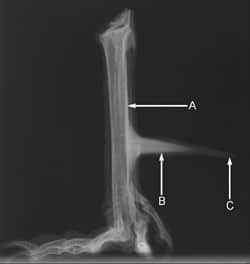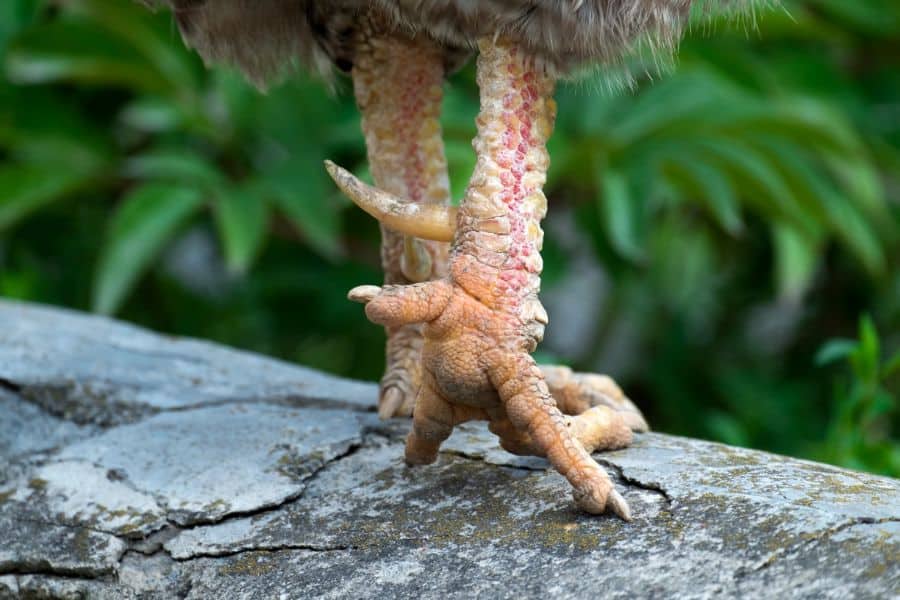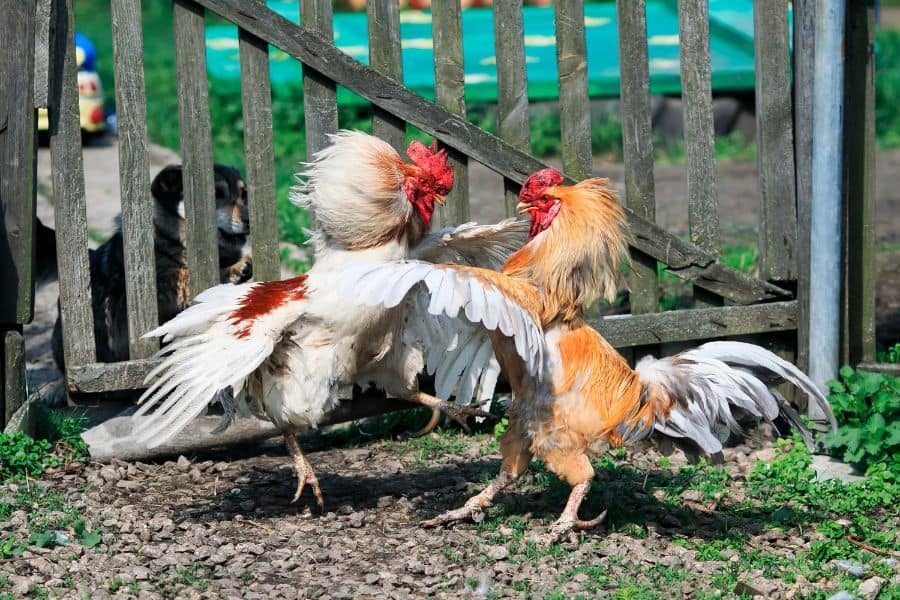In a free-range flock of chickens, the rooster spurs are among the deadliest weapons in the rooster’s arsenal against threats. Depending on which side of the conflict you reside in, the spurs are majestic tools or wickedly mean-looking nuisances.
The bony leg structure makes a rooster fearsome in any cockfight. As much as a hard-fierce beak, wide wings, thick heavy claws, and a heavier body adds to the strength of the rooster, the spurs perform a unique purpose because of where they are located on the chicken’s body.
Read on to know everything that there is to know about the rooster spurs. Get to learn why it is not a good indicator of gender, how they grow, how to address certain issues that may arise due to their presence, and how to apply remedies to these situations.
What Is A Spur On A Rooster?
A rooster spur is a bony, pointy, natural anatomical structure, that grows on the shanks of the rooster’s legs, right between the toes and ankles.
Shown below:
The spur is made up of the calcar (part B) and a horny layer made of keratin (part C). Keratin is the same biological compound that the chicken beak, toenails, and fingernails are made of.
The horny layer acts as a cover on the outside which protects the inner calcar (soft and less dangerous). The spur is connected to the main leg bone via the tarsometatarsal bone (part A).
The horny keratinized layer is the only section of the spur that can grow back in case of an injury or if it is surgically trimmed, filed, or removed. It is similar to your fingernails and toenails which will always grow back no matter how many times you trim or file them.
Spurs point inwards which makes them very efficient in spearing fights. If you have ever seen a cockfight then you can picture the leg movements they usually make when jumping onto one another. Roosters ensure they have a maximum force to spear by positioning their legs wide open while in the air and then bringing them together when landing on their opponents.
Even though most people refer to them as rooster spurs, the structures are not only found in roosters. Hens have spurs too albeit in much lower numbers. Also, the spurs in hens are usually more like spur buds rather than fully-grown spurs.
Also, not all roosters have spurs. Some will have spur buds without fully formed spurs while others will have elongated spurs that can become too long with age to the point of harming the rooster himself.
In general, roosters will develop spurs as they mature. However, the growth of spurs is influenced by genetics, age, and breed. Some roosters may have smaller and less prominent spurs, while others may have larger and more pronounced ones.
Certain chicken breeds are known for having more prominent spurs, while others may have spurs that are less noticeable. Additionally, the growth of spurs tends to be more prominent in older roosters as they reach sexual maturity.
Also, you may be asking, are rooster spurs poisonous?
The spurs are not poisonous in the sense that they do not carry a poisonous agent like in snake venom. Instead, the spurs are dangerous because they can easily leave a nasty wound on the body which if not treated could lead to dangerous infections.
Germs can spread quickly from the chicken spur attack. The best way to treat this is to immediately wash the wound with warm water, and antiseptic, and properly cover it up with bandages.
Also Read: What to Do When a Rooster Attacks You?
What Is The Function Of The Spur On A Bird?
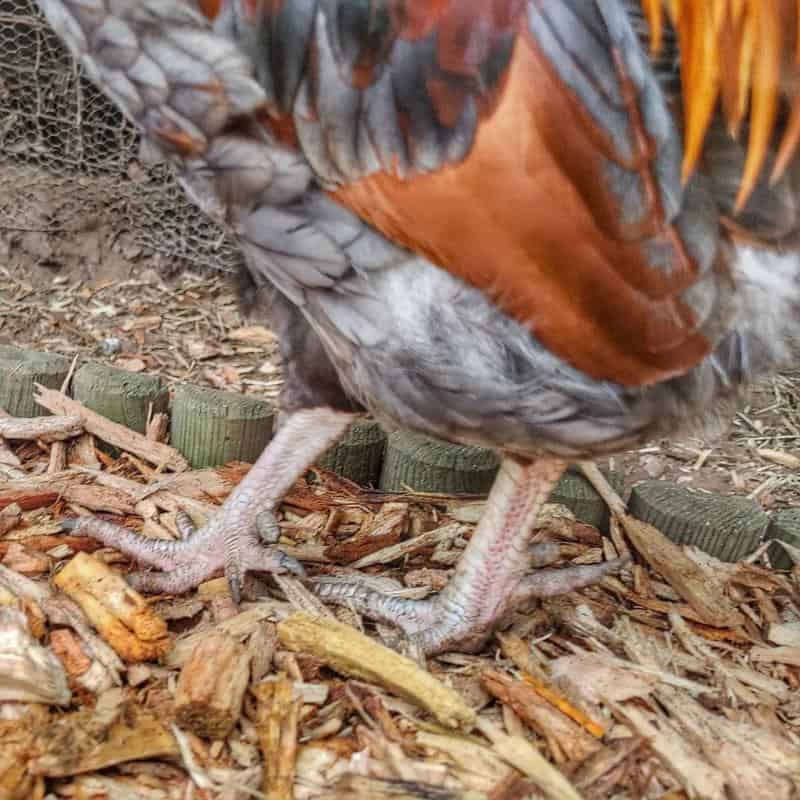
The reason why roosters have spurs is related to the fact that roosters are romantically inclined to protect their hens. Having this sharp weapon in their arsenal adds to their strength to fight over territory, hens, and dominance, and protect hens from predators like cats & dogs.
Roosters use spurs as weapons during territorial disputes and to establish dominance within the flock. They will engage in sparring matches with other roosters, where they may kick and jab at each other with their spurs.
Spurs are also used as mating displays during the breeding season. The spurs are used to attract hens and the roosters might strut to show off their spurs as part of their exquisite way of elaborating mating rituals.
When Do Roosters Grow Spurs
Roosters begin to grow spurs during their early development when the baby is forming. The growth continues through birth and as they reach sexual maturity. The timing of how quickly they develop can vary based on several factors, including breed, genetics, and individual maturity rates.
Small spur buds start showing at around 3- 4 months of age. These are the early stages of spur growth. As the rooster continues to mature, these bumpy areas will gradually develop into fully-formed spurs made of bony tissue.
The age at which the fully developed spurs start showing and become prominent varies too. Each breed has its own individual growth rate and some will show faster than others.
However, as a general rule, spurs start to appear on roosters at about 5 – 8 months of age. The spurs can continue to change even after this age, getting bigger and bigger as the rooster ages. In any given flock, the oldest roosters tend to have larger and more well-developed spurs than younger roosters.
Should Rooster Spurs Be Removed?
Chances are you came across this article because you were considering removing the spurs from your rooster. But before we go ahead and show you how to do that, how about we tell you why it might not be a good idea!
1. Pain & Damage to the Hen
Only the exterior part of the spur is hard and bony with little worry about pain or infections. Once you trim or remove the entire outer coating, the soft and fleshy interior will be exposed. This can lead to infections, cuts, and other injuries.
Also, the physical removal itself will cause pain to the chicken.
The good news about removing the spur is the fact that it will grow back after a couple of weeks, thereby covering the inner tissue once again. It will still take months before it returns to its original shape and size.
However, during this time, the skin is more exposed to the outside exposing the sensitive areas that are more vulnerable to injuries and infections.
2. Leaving The Rooster Defenseless
Just because the spur is removed, doesn’t mean the rooster won’t remain territorial, and want to fight, defend, and mate.
The rooster will still display its innate aggression and the lack of the spur will leave the animal defenseless and less able to face the danger.
With this in mind, removing the roster spurs does not solve the problem – The rooster will still remain aggressive, and territorial, and get into fights but sadly it will be less capable, only relying on its beak and claws.
Also Read: Fighting Roosters Breeds
Reasons For Trimming Rooster Spurs
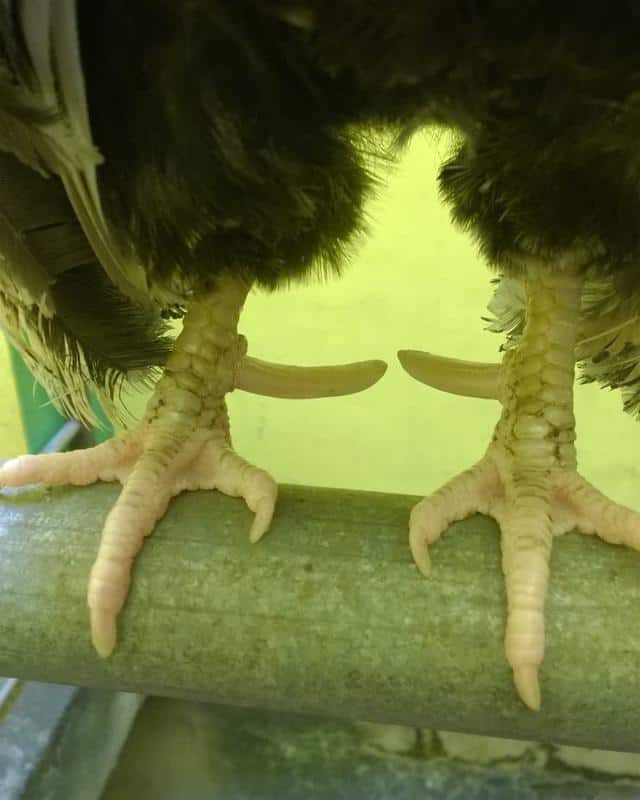
Trimming is when you cut the elongated ends of the bony spur exterior to reduce the length to a reasonable size that won’t injure the rooster or other animals.
There are a few reasons for this:
1. Safety & Reduce Injuries
Rooster spurs can be sharp and pointed, and if left untrimmed, they can cause injuries to other chickens, humans, or animals in the vicinity. Trimming the spurs helps reduce the risk of accidental scratches or punctures, making interactions with the rooster safer.
2. Old Rooster With Curly Spurs
Overgrown spurs can sometimes curl or grow in abnormal directions, causing discomfort or difficulty for the rooster when walking or moving. This is more so the case in older roosters. Trimming the spurs can help maintain the rooster’s comfort and mobility.
3. Harming Hens During Mating Season
During mating, the rooster may inadvertently cause injuries to hens with his spurs. Trimming the spurs can help minimize the risk of injury to the hens while still allowing the rooster to perform his natural mating behaviors.
4. Over-Aggression
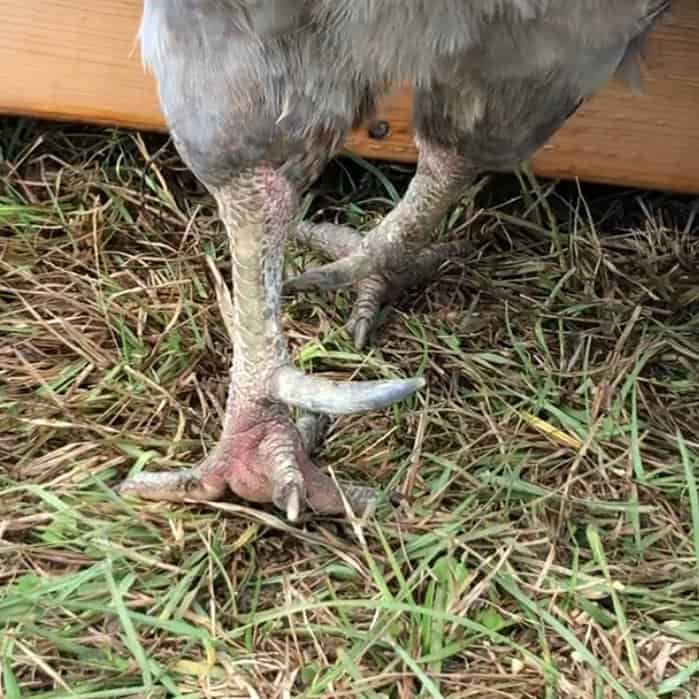
You may also want to remove them if you constantly worry about the aggression of the rooster towards humans and other animals in the environment.
In some cases, roosters with large or prominent spurs may become overly aggressive, especially during mating or territorial disputes. Trimming the spurs can help reduce the potential for causing harm to other chickens or humans during aggressive encounters.
When & How To Remove Rooster Spurs
The first thing to remember when thinking of removing rooster spurs is how potentially painful and invasive the process can be. With this in mind, it is recommended you seek the advice of a veterinarian before you proceed.
The only reason why removing the rooster spur is a good idea is when the spur has become too large and the growth rate is abnormal. In this case, trimming is an inefficient method, and removing the entire spur can solve the problem.
Even though the rooster will remain defenseless, removing the spur can be worth it when there is more harm than good.
However, keep in mind that if your rooster was over-aggressive and mean then removing the spur won’t solve the issue – the only solutions to this is to keep the rooster calmer, reduce his stress levels, have plenty of hens for mating, provide enough food and water, have a safe environment, and comfortable shelter.
When taking the rooster to the vet, anesthesia is used to numb the area around the spurs. Specialized cutting tools are used to carefully remove the spur and cauterization may be used if there is a lot of bleeding. Best of all, there will be aftercare protocols that will be recommended to ensure proper healing.
If you want to remove the spur yourself then there is an old ‘Hot Potato Method’ that has been in use for ages.
The ‘Hot Potato Method’ is where you heat a potato to a high temperature in a microwave or hot water pot and then use the hot potato to soften the outer layer of the spur. You then proceed to use a pair of pliers to softly and gently twist the outer spur layer off, removing the longer exterior and maintaining a small interior calcar. The outer layer will later regrow and reform.
The best method for removing the spur is through a surgical process done by a veterinarian. It is less painful, healthier for the rooster, and minimizes complications.
Read More: How To Stop A Rooster From Crowing
Frequently Asked Questions
Do Roosters Shed Their Spurs
Roosters do not shed their spurs. It is the same way they do not shade their toes. Spurs are bony protrusions that are part and parcel of the chicken’s leg. Once they have fully developed, they are permanent throughout the rooster’s life.
Does It Hurt A Rooster To Remove His Spurs?
Removing a rooster’s spur is painful and very uncomfortable. It is for this reason that the most recommended method of removing spurs is by consulting a veterinarian. Older methods of manually removing the spurs are ineffective at eliminating the pain caused by the procedures.
Conclusion
A rooster spur is a natural part of the chicken that often does not need to be removed. It is a handy feature for protection, and in the case that it grows bigger into a problem, it can be trimmed and filed to a smaller length which is more manageable.
However, if you want to remove the spurs, feel free to pay a visit to your local veterinarian to have the necessary expertise and equipment that will ensure a swift and efficient removal method.
